By Nicki Richesin, The Children’s Book Review
Published: March 21, 2012
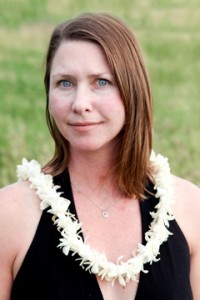
Amy Novesky is the author of Elephant Prince; Me, Frida and most recently Georgia in Hawaii. A former editor at Chronicle Books, Novesky brings years of experience to her work as both a children’s book editor and author. She teaches writing workshops to aspiring authors and is co-founder of Ever After Studio, a children’s book production company and the creative director of Paper Hat Press, a company that creates customizable children’s book and keepsakes. She discussed her research on Georgia O’Keeffe (in Hawaii) and Billie Holiday and Imogen Cunningham for her forthcoming books Mister and Lady Day and Imogen.
Nicki Richesin: Congratulations on the publication of Georgia in Hawaii! When I think of Georgia O’Keeffe, I tend to think of her hiking on Ghost Ranch. What inspired you to tell this story of her trip to Hawaii?
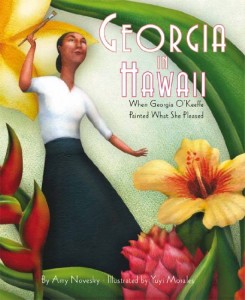 Amy Novesky: I think most people think of Georgia that way, and there are some beautiful picture books that tell that story. But few people know that Georgia painted in Hawaii, and that’s exactly why I wrote this book. Imagine this painter famous for painting flowers and landscapes, painting in the most beautiful flower-filled landscape of all. I also wrote this book because I have a connection to Hawaii, and if there was any Georgia book I was going to write, it was this one.
Amy Novesky: I think most people think of Georgia that way, and there are some beautiful picture books that tell that story. But few people know that Georgia painted in Hawaii, and that’s exactly why I wrote this book. Imagine this painter famous for painting flowers and landscapes, painting in the most beautiful flower-filled landscape of all. I also wrote this book because I have a connection to Hawaii, and if there was any Georgia book I was going to write, it was this one.
NR: March is Women’s History Month and you have published wonderful books on truly remarkable women like Frida Kahlo and Georgia O’Keeffe and even more coming soon. What do you look for in a person’s life to make you want to tell his or her story and how do you find the hook that will appeal to a broad audience of readers?
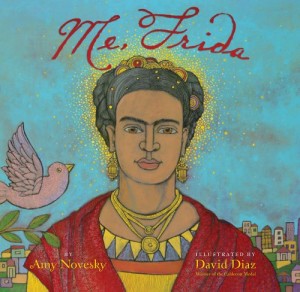 AN: Most stories start with the art. I am drawn to the art. Often, though, I’m drawn as much, if not more, to the artist. For example, I knew I wanted to write stories about both Frida Kahlo and Billie Holiday, but with each I didn’t want to tell the typical narrative. And then, too, especially with Frida and Billie, I had the added challenge of finding a story that was kid-friendly, given how tragic both of their lives were. (Frida had polio as a child and was in a horrific accident as a young adult; Billie was a child prostitute and a drug addict). For Frida, like Georgia, when I learned that she’d lived in San Francisco, my city, I knew that that was the story I wanted to write. A lot of it is finding a personal connection to the story. But there wasn’t much of a story there, and so the story gathered dust for years, until I found a way to make it work. I invented an earthquake, a creative liberty, editors, rightly so, were not comfortable with. But, oh, that was a fun story! And then, I discovered one detail, a footnote (Frida’s first art show), which amounted to one new sentence, and that made all the difference. A static story became dynamic. With Billie, I couldn’t believe that there were no picture books about her—one of the most famous singers of all time—but when I started researching her, I realized why: how do you write about someone who worked in a brothel as a child, who abused drugs, who went to prison, who died young? You write about her dogs. Billie loved her dogs. And when I learned her favorite was a boxer named MisterMister and Lady Day!—I not only had a title, I had my hook. The book is dedicated to my own beloved dog, George.
AN: Most stories start with the art. I am drawn to the art. Often, though, I’m drawn as much, if not more, to the artist. For example, I knew I wanted to write stories about both Frida Kahlo and Billie Holiday, but with each I didn’t want to tell the typical narrative. And then, too, especially with Frida and Billie, I had the added challenge of finding a story that was kid-friendly, given how tragic both of their lives were. (Frida had polio as a child and was in a horrific accident as a young adult; Billie was a child prostitute and a drug addict). For Frida, like Georgia, when I learned that she’d lived in San Francisco, my city, I knew that that was the story I wanted to write. A lot of it is finding a personal connection to the story. But there wasn’t much of a story there, and so the story gathered dust for years, until I found a way to make it work. I invented an earthquake, a creative liberty, editors, rightly so, were not comfortable with. But, oh, that was a fun story! And then, I discovered one detail, a footnote (Frida’s first art show), which amounted to one new sentence, and that made all the difference. A static story became dynamic. With Billie, I couldn’t believe that there were no picture books about her—one of the most famous singers of all time—but when I started researching her, I realized why: how do you write about someone who worked in a brothel as a child, who abused drugs, who went to prison, who died young? You write about her dogs. Billie loved her dogs. And when I learned her favorite was a boxer named MisterMister and Lady Day!—I not only had a title, I had my hook. The book is dedicated to my own beloved dog, George.
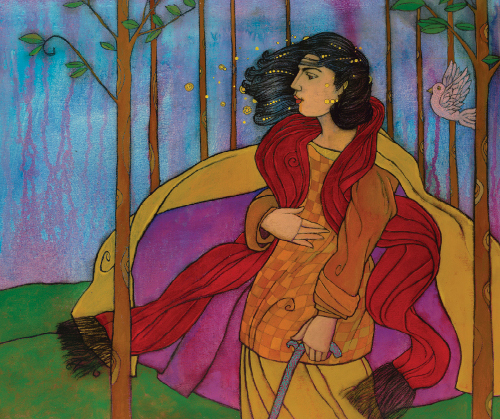
NR: Your upcoming book (Fall 2012) Imogen follows the life of Imogen Cunningham and is illustrated by another incredible artist Lisa Congdon. Why did you want to tell Imogen’s story?
AN: When I was researching Frida in San Francisco, I came across a photograph of her taken by a photographer named Imogen Cunningham. Frida led me to Imogen. Imogen Cunningham was one of the most accomplished photographers of her time, alongside well-known names like Ansel Adams and Dorothea Lange, and yet no one has heard of her. Why is that? Is it because she was a mother and taken less seriously as an artist? That’s exactly what I love about her: she raised three boys (including a set of twins) while she made her art. She was a photographer and a mother. She found a way to do both. She had to. This greatly resonates with me, writing while raising a son, as I imagine it resonates with many moms who work hard to balance both family and work. Imogen included her sons in her work. They were oftentimes not only in the background, but in the foreground: she photographed them. Rondal, one of her sons, helped her develop her film; he grew up to be a photographer, and, his daughter is none other than award-winning children’s book author Elizabeth Partridge.
NR: You worked as an editor at Chronicle Books before becoming an author. What did you learn at Chronicle about book publishing that has helped you become a successful author?
AN: Many things. I learned how to be a good editor, and that has greatly influenced my writing. Not all editors write, but I was a writer before I was an editor. I learned how to make a book from start to finish. And, reviewing thousands of submissions each year, 99% of which were not good, I learned the utter importance of writing not only a good (or good enough) story, but a great one. If you don’t know what makes a story great, you shouldn’t be writing them.
NR: You also have a book about Billie Holliday and her dogs Mister and Lady Day that will be published in 2013. Billie Holliday certainly seemed like a great lady with such grace and sophistication. I once read that she wasn’t allowed as a patron in many of the theatres in which she performed on stage. Could you tell us a bit about this book?
AN: Like Georgia and Frida, I was drawn to Billie, not only as an artist, but as a person. Billie was indeed graceful, but deeply troubled and at a troubled time. (She did indeed have to use separate entrances from her white band members). I wanted to write a book about a girl who wanted to sing and who became one of the most famous singers of all time, despite her troubles. Billie went to prison for drug possession at the height of her career. While my editor and I chose not to say in the story exactly where she went and why, it is there; her leaving provides the story’s tension and poignancy, and I talk about where and why in the Author’s Note. While Billie was in prison, she didn’t sing for an entire year. But ten days after she returned home she performed a triumphant concert at Carnegie Hall. That’s how I want her to be remembered—singing.
NR: You also co-founded a children’s book production company Ever After Studio. How did you begin working on this company and what books are you currently working on?
AN: I started EAS with my good friend and fellow independent editor Erica Jacobs Green (formerly of Chronicle Books). (This is my second book production company; the first was Pink Moon Studio, which I started with Chronicle Books Art Director Kristine Brogno. Our book, Lullaby By Langston Hughes is due out this fall from Harcourt). We love to make kids’ books. And that’s what we do. We find concepts and stories we love (our own and others’), we develop them, and then we pitch them to publishers. Our current list includes a combination of picture books and book+ concepts. And we have a children’s novel/screenplay in early development. I should add that we do not accept submissions—sorry!
NR: If you could be reincarnated as any character in children’s literature, who would it be and why?
AN: The characters who come to mind—Max from Where the Wild Things Are, the girl from Island of the Blue Dolphins, the boy from The Black Stallion–were all marooned on islands, be it with monsters, a wild horse, or all alone. I must have a thing for wanting to live on an island.
NR: I’m told you lead fantastic workshops for children on creative writing and making books. Do you ever find yourself coming up with ideas while working with children and later developing them into a book?
AN: Actually, my writing workshops are for adults (I hope they’re still fantastic!). But I do visit schools often and talk with kids of all ages about the process of making a book. My 6-year-old son loves to write and illustrate his own. His are much better than mine. One is called The Boot and the Table for the Boot’s Birthday (subtitle: Silly Story). Being with him inspires ideas. For one, I want to capture his childhood in a book. I’m not sure yet how to do that, but if there’s one book I want to write, it’s that one.
NR: Many of our readers are aspiring authors and illustrators. What is one piece of advice you would give to them about writing and illustrating books for children?
AN: Believe whole-heartedly in what you write. If you don’t, no one else will.
NR: Which projects are you currently working on?
AN: I am working on a few new picture books about artists, including one who as a girl was barred from the museum but grew up to make art that ended up not only in the Whitney but in the White House. I am working on a book about the ocean with a Hawaiian contemporary artist. And I’m working on a book or two about a girl marooned on an island.
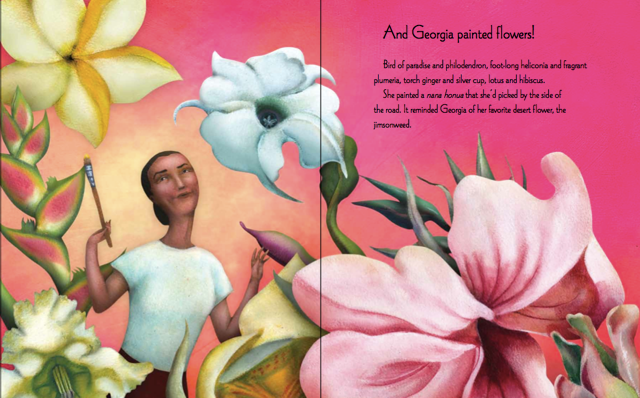
Thank you so much for your time, Amy. Best of luck with all of your books!

1 Comment
Pingback: Meet the Biographer: Amy Novesky « Kidsbiographer's Blog